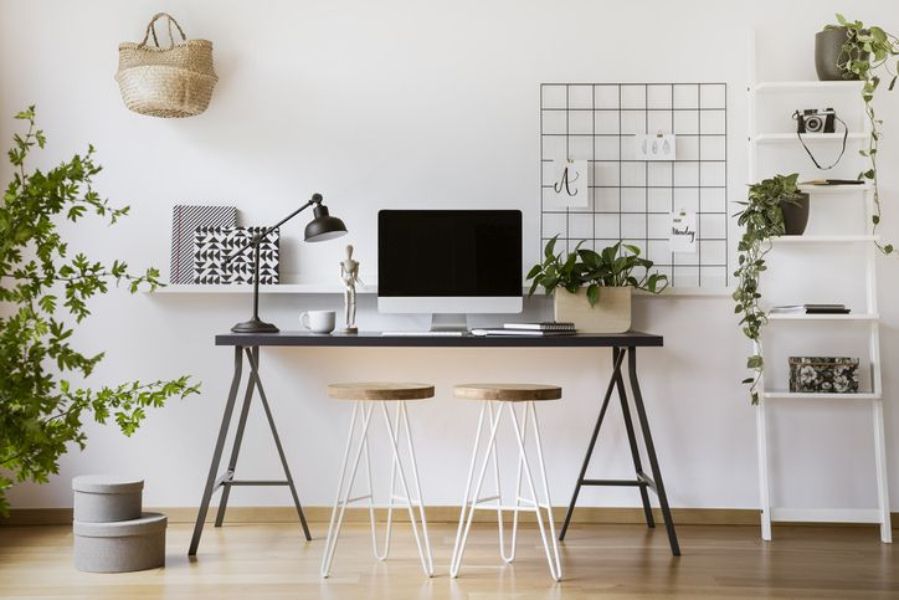Whether you work from home a few days a week or full-time, it’s vital to create an at-home office space. Without having an office space to work in, you may find that your productivity suffers, and you’re more easily distracted. Ever tried to work on the sofa with your TV on in the background?
You’ll quickly realise that it’s no easy feat! If you need to create a workspace in your home but don’t know where to begin, take a look at these simple tips on creating the perfect home office.
Make it comfortable

One of the most important aspects of any desk is that you’re comfortable. Far too many of us don’t consider the impact that our posture and the way we sit can have. It’s so important to choose ergonomic styles of furniture and desk accessories that will help you work comfortably and avoid causing back or shoulder pain which can negatively impact your productivity.
Invest in a high-quality desk and chair. Remember that if you work from home full-time, you’ll be spending the majority of your day sitting at this desk, so it’s definitely worth it to spend a little more cash.
Other accessories that you might need include a stand to lift your screen to reach eye level, and a plug-in mouse and keyboard if you’re working off a laptop.
Add plants
Plants have so many benefits that make them perfect to use in a home office. Not only do house plants look great and have the ability to brighten up your space, but they also improve air quality, helping you work in a healthy and uplifting environment.
Some great house plants that should be considered for use in your home office include the Aloe Vera, Peace Lilly and Snake Plant, all of which are known for their air purifying abilities.
Choose colours that work for you
The colours we use in the home can have a big impact on our mood and the atmosphere that’s created. For instance, if you want a good night’s sleep, you’d generally avoid painting your bedroom in a bold and stimulating colour. Your home office is just the same and should be painted in shades which are going to help you stay focused and get you in a creative mindset.
According to colour psychology, the colours that work well in a home office include yellow, blue, and green. Yellow boosts creativity and happiness, blue aids focus, and green provides a sense of balance and tends to be easy on the eyes if viewed for long periods of time.
Of course, even though you’re using these colours, it doesn’t mean you need to paint every wall in this shade. Often, pairing brighter pops of colour with minimal colour schemes works best. Painting walls in pure white can create a distraction-free space that allows you to focus your mind more easily while looking stylish and modern at the same time.
Many popular property companies tend to use minimal colours in their rental properties, recognising the appeal of this style of decor. RW Invest, who offer buy to let properties in Liverpool and Manchester, cater towards their demographic of students and young professionals with modern, fuss-free apartments that are perfect for at home working or studying.
Hang artwork

If your desk is positioned right in front of a wall, you’ll want to have some nice things to look at throughout the day. A blank wall does nothing for motivation, so make sure you decorate with some inspiring artwork.
You could hang up framed artwork from your favourite artists or illustrators, frame motivational quotes, or create a mini mood-board with imagery that helps stimulate you and get you in a good working mindset. This way, no matter how dull the task at hand, you’ll always feel inspired and uplifted by your beautiful surroundings!
To kill two birds with one stone, consider hanging a calendar or to-do list with a cheerful print or design. This way, you’re filling wall space with something that looks good but also has a practical purpose.
Let in lots of natural light
When you’re cooped up in one room for most of the day, the last thing you want is to have to rely on artificial light. Not only does using desk lamps or artificial lighting use up energy, but it could also cause eye-strain which can, in turn, affect your productivity levels.
Try and let as much natural light in as possible throughout the working day, drawing curtains and blinds and even opening your windows for some fresh air from time to time.
If you’re conscious about privacy, you could add a frosted film to the windows or introduce sheer curtains which will still let lots of light through without allowing people to see inside.
